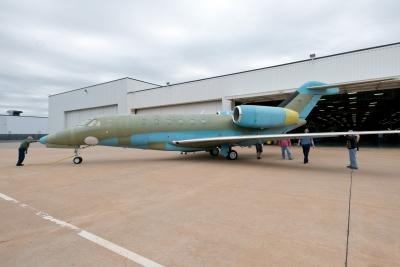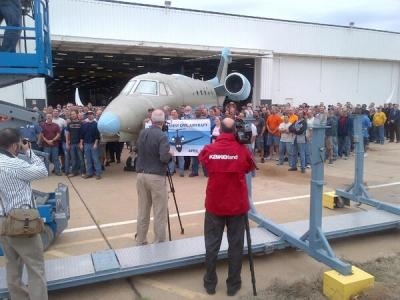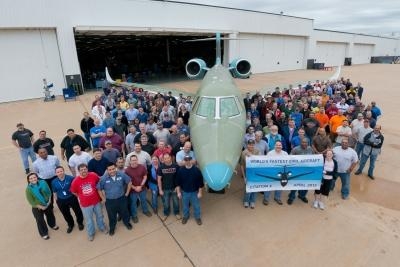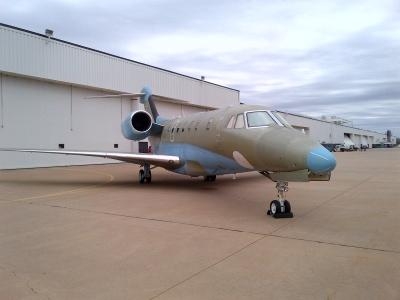Wed, Apr 17, 2013
Airplane Rolled Out Of Cessna's Wichita, KS, Production Facility
The first production unit of the new Citation X has been rolled out at Cessna's Wichita, KS, manufacturing facility. First announced at NBAA in 2010, the new airplane is best known for its top speed of Mach 0.935, which Cessna says makes it the fastest civilian aircraft in the world.

"Speed is the reason for flight. It was true for Clyde Cessna in 1927, and it's true today," said Scott Ernest, Cessna CEO. "The Citation X is the perfect aircraft for customers wanting to move faster, be more efficient and get where they need to be more quickly than ever before."
Employees at Cessna's Wichita manufacturing facility celebrated the rollout. "It is exciting to see this new Citation X roll out the door. The improved capability and features of this aircraft have been received very favorably, especially with the new maximum speed of Mach 0.935. Being part of the fastest business jet in aviation is exciting for Cessnans," said Kelly Reich, business leader for the Citation X. "Cessnans take great pride in this aircraft. It is especially satisfying to see the improvements in performance and features that have been incorporated in the new Citation X."
The increased speed is not the only improvement for the flagship of the Citation fleet. The Citation X provides a lengthier cabin and a longer range of 3,242 nm. The increased range translates into an aircraft which can easily handle the flight from New York to London. The cockpit is equipped with the groundbreaking Garmin G5000 integrated avionics package, featuring three 14" primary displays and four touch screen controllers for data entry and systems control.

More than 675 flight hours have been logged on two test aircraft in the Citation X program. Cessna expects certification later this year with customer deliveries starting shortly thereafter.
The Citation X is expected to have a maximum altitude of 51,000 feet, allowing the aircraft to fly above commercial traffic or adverse weather. Perhaps the most distinct outward difference with the evolved Citation X are the winglets at the tips of the main wing which allow the aircraft to cruise efficiently at higher altitudes, allow for lower fuel consumption, and improve takeoff and landing performance at higher elevations or on hot days.


More News
Also: B-29 Superfortress Reunion, FAA Wants Controllers, Spirit Airlines Pulls Back, Gogo Galileo Van's Aircraft posted a short video recapping the goings-on around their reorganiz>[...]
Light Gun A handheld directional light signaling device which emits a brilliant narrow beam of white, green, or red light as selected by the tower controller. The color and type of>[...]
"The journey to this achievement started nearly a decade ago when a freshly commissioned Gentry, driven by a fascination with new technologies and a desire to contribute significan>[...]
"Our driven and innovative team of military and civilian Airmen delivers combat power daily, ensuring our nation is ready today and tomorrow." Source: General Duke Richardson, AFMC>[...]
Aircraft Conflict Predicted conflict, within EDST of two aircraft, or between aircraft and airspace. A Red alert is used for conflicts when the predicted minimum separation is 5 na>[...]
 Airborne 04.16.24: RV Update, Affordable Flying Expo, Diamond Lil
Airborne 04.16.24: RV Update, Affordable Flying Expo, Diamond Lil ANN's Daily Aero-Term (04.20.24): Light Gun
ANN's Daily Aero-Term (04.20.24): Light Gun Aero-News: Quote of the Day (04.20.24)
Aero-News: Quote of the Day (04.20.24) Aero-News: Quote of the Day (04.21.24)
Aero-News: Quote of the Day (04.21.24) ANN's Daily Aero-Term (04.21.24): Aircraft Conflict
ANN's Daily Aero-Term (04.21.24): Aircraft Conflict






